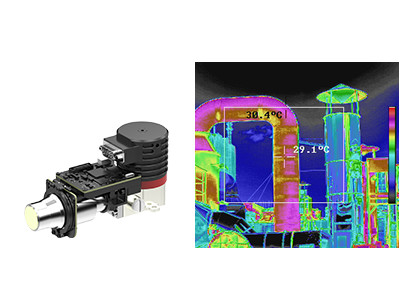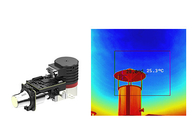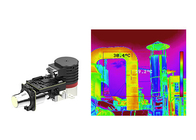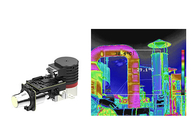-
Thermal Camera Core
-
Thermal Security Camera
-
Drone Thermal Camera
-
EO IR Systems
-
Cooled Infrared Detectors
-
Thermal Imaging Binoculars
-
Cooled Camera Modules
-
Optical Gas Imaging
-
Infrared Thermal Camera Module
-
High Resolution Thermal Camera Module
-
Thermal Camera For Fever Detection
-
Vehicle Mounted Thermal Camera
-
Integrated Dewar Cooler Assembly
-
Uncooled Infrared Detectors
MWIR Cooled Optical Gas Detection Thermal Module 320x256 30μM

Contact me for free samples and coupons.
Whatsapp:0086 18588475571
Wechat: 0086 18588475571
Skype: sales10@aixton.com
If you have any concern, we provide 24-hour online help.
x| Function | Gas Leak Detection | Cryo Cooler | RS058/RS058I |
|---|---|---|---|
| Detector Resolution | 320x256 | Pixel Size | 30μm |
| NETD | 10mK (F1.5) | Spectral Range | 3.2±0.1~3.5±0.1μm |
| Highlight | MWIR Cooled Optical Gas Detection,320x256 Optical Gas Detection,RoHS Optical Gas Imaging Module |
||
320x256 30μM MWIR Cooled Optical Gas Imaging Thermal Module For Visualizing Gas Leaks
EYAS330G cooled AD module is developed on the basis of C330M-G cooled infrared detector and equipped with high performance signal processing circuit. It is an accelerator for customers who have difficulty in starting fast optical gas imaging system integration. By utilizing the infrared technology, the invisible volatile organic compounds (VOCs) leaks can be quickly and effectively detected to ensure the safety in production, transportation and processing of petrochemical enterprises.
Shorten Development Cycle
• Adopt high-performance signal processing circuits to realize the conversion of analog signal to digital signal
• Support 12V power supply for explosion-proof certification
Easy & Fast Integration
• Cameralink interface output 16-bit RAW data, serial port control
• Integrated structure that has consistent dimension with detector
| Model | EYAS330G | EYAS330G2 |
| Performance | ||
| Resolution | 320×256 | |
| Pixel Size | 30μm | |
| Cryocooler | RS058 | RS058I |
| Spectral Range | 3.2μm±0.1μm~3.5μm±0.1μm | |
| Cooling Time (25℃) | ≤6min30s | ≤7min |
| Typical NETD | 10mK (F1.5) | |
| Working Mode | ||
| Frame Rate | 1~200Hz (Adjustable) | |
| Working Mode | Snapshot; ITR Integration Mode; Windows Mode; Anti-blooming | |
| Electrical Specifications | ||
| Standard External Interface | QSH 60pin | |
| Digital Video | Cameralink Output: 16bit Raw Data | |
| External Sync | CC1: INT Frame External Sync CC2: MC External Sync |
|
| Communication | Cameralink Serial Port: TFG+/-, TC+/-, 9600bps | |
| Power Supply | Channel 1 Imaging Panel: 5V Channel 1 Cryocooler: 24V |
Channel 1 Imaging Panel: 5V Channel 1 Cryocooler: 12V |
| Stable Power Consumption | 7W | |
| Size (mm) | 142×58.5×71 | |
| Weight | ≤680g | |
| Working Temperature | -40°C~+60°C | |
The EYAS330G cooled AD module is used for visiualizing the invisible VOCs (volatile organic compounds) and detecting gas leakage such as: Methane, Ethane, Propane, Butane, Pentane, Hexane, Heptane, Octane, Ethylene, Propylene, Isoprene, Methanol, Ethanol, Butanone, Benzene, Toluene, Xylene, Ethylbenzene etc.
![]()
1. How to choose proper infrared detector resolution?
It depends on the actual needs and applications of your products, and the price is also a factor that needs to be considered. If the image quality is not high, you can choose the infrared detector with low resolution, such as 120x90, 256x192, 400x300. If you need a very clear image for some special purposes, such as remote monitoring, you can choose a high resolution infrared detector of 1280x1024.
2. How to select right pseudo color for thermal imaging?
- The gray white is more suitable for the target with small temperature difference
- The red and blue is more suitable for the scene where the problem points need to be found.
- The iron red is the standard color palette of the power industry.
Note: no matter which palette you choose, the thermal temperature will not change at all.
3.How to choose a suitable infrared thermal camera lens?
- Standard lens can meet normal targets with appropriate distance
- For the telephoto lens, it’s suitable for targets that is relatively small and needs to be viewed from a long distance
- To see more detail of objects at close distance, wide angle lens is better.
- Macro lens is for seeing very tinny target with close distance, such as chip circuit














